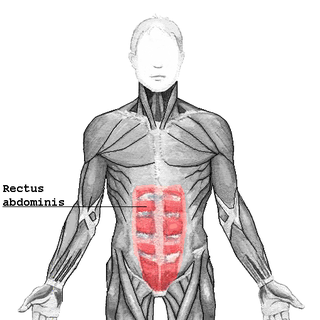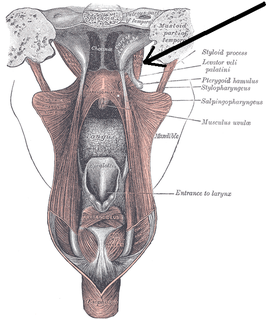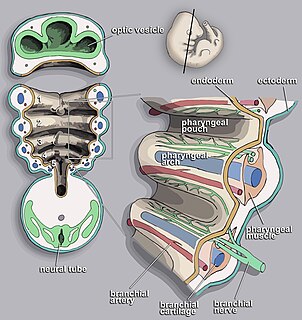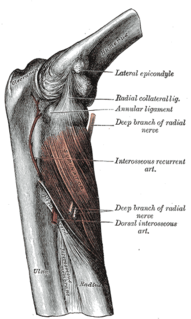In grammar, tense is a category that expresses time reference with reference to the moment of speaking. Tenses are usually manifested by the use of specific forms of verbs, particularly in their conjugation patterns.

The mandibular nerve (V3) is the largest of the three divisions of the trigeminal nerve, the fifth cranial nerve (CN V).

Skeletal muscle is one of three major muscle types, the others being cardiac muscle and smooth muscle. It is a form of striated muscle tissue, which is under the voluntary control of the somatic nervous system. Most skeletal muscles are attached to bones by bundles of collagen fibers known as tendons.

The gluteus minimus, the smallest of the three gluteal muscles, is situated immediately beneath the gluteus medius.

The rectus abdominis muscle, also known as the "abdominal muscle" or "abs", is a paired muscle running vertically on each side of the anterior wall of the human abdomen, as well as that of some other mammals. There are two parallel muscles, separated by a midline band of connective tissue called the linea alba. It extends from the pubic symphysis, pubic crest and pubic tubercle inferiorly, to the xiphoid process and costal cartilages of ribs V to VII superiorly. The proximal attachments are the pubic crest and the pubic symphysis. It attaches distally at the costal cartilages of ribs 5-7 and the xiphoid process of the sternum.

The ulnar collateral ligament is a thick triangular band at the medial aspect of the elbow uniting the distal aspect of the humerus to the proximal aspect of the ulna.
Sequence of tenses is a set of grammatical rules of a particular language, governing the agreement between the tenses of verbs in related clauses or sentences.

The iliopsoas refers to the joined psoas and the iliacus muscles. The two muscles are separate in the abdomen, but usually merge in the thigh. As such, they are usually given the common name iliopsoas. The iliopsoas muscle joins to the femur at the lesser trochanter, and acts as the strongest flexor of the hip.

The tensor veli palatini muscle is a broad, thin, ribbon-like muscle in the head that tenses the soft palate.

The tensor fasciae latae is a muscle of the thigh. It is related to the gluteus maximus in function and structure and is continuous with the iliotibial tract, which attaches to the tibia. The muscle assists in keeping the balance of the pelvis while standing, walking, or running.

The anterior superior iliac spine is a bony projection of the iliac bone and an important landmark of surface anatomy.
It refers to the anterior extremity of the iliac crest of the pelvis, which provides attachment for the inguinal ligament, and the sartorius muscle. The tensor fasciae latae muscle attaches about 5 cm away at the iliac tubercle.

The pharyngeal arches —also known as visceral arches—are structures seen in the embryonic development of vertebrates that are recognisable precursors for many structures. In fish the arches are known as the branchial arches or gill arches.

The iliotibial tract or iliotibial band is a longitudinal fibrous reinforcement of the fascia lata. The action of the ITB and its associated muscles is to extend, abduct, and laterally rotate the hip. In addition, the ITB contributes to lateral knee stabilization. During knee extension the ITB moves anterior to the lateral condyle of the femur, while ~30 degrees knee flexion, the ITB moves posterior to the lateral condyle. However, it has been suggested that this is only an illusion due to the changing tension in the anterior and posterior fibers during movement. It originates at the anterolateral iliac tubercle portion of the external lip of the iliac crest and inserts at the lateral condyle of the tibia at Gerdy's tubercle. The figure shows only the proximal part of the iliotibial tract.

The trigeminal motor nucleus contains motor neurons that innervate muscles of the first branchial arch, namely the muscles of mastication, the tensor tympani, tensor veli palatini, mylohyoid, and anterior belly of the digastric. This nucleus is located in the mid-pons.

The anterior fontanelle is the largest fontanelle, and is placed at the junction of the sagittal suture, coronal suture, and frontal suture; it is lozenge-shaped, and measures about 4 cm in its antero-posterior and 2.5 cm in its transverse diameter. The fontanelle allows the skull to deform during birth to ease its passage through the birth canal and for expansion of the brain after birth.

The iliofemoral ligament is a ligament of the hip joint which extends from the ilium to the femur in front of the joint. It is also referred to as the Y-ligament or the ligament of Bigelow, and any combinations of these names.

The frontopontine fibers are situated in the medial fifth of the base of the cerebral peduncles; they arise from the cells of the frontal lobe and then pass through the anterior limb of internal capsule at last end in the nuclei of the pons.

The interosseous membrane of the forearm is a fibrous sheet that connects the interosseous margins of the radius and the ulna. It is the main part of the radio-ulnar syndesmosis, a fibrous joint between the two bones.
Relative tense and absolute tense are distinct possible uses of the grammatical category of tense. Absolute tense means the grammatical expression of time reference relative to "now" – the moment of speaking. In the case of relative tense, the time reference is construed relative to a different point in time, the moment being considered in the context. In other words, the reference point is the moment of discourse or narration in the case of absolute tense, or a different moment in the case of relative tense.














